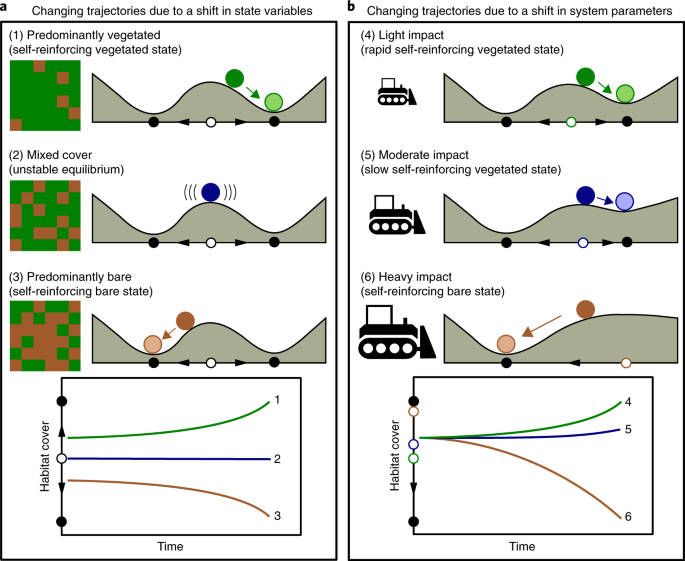Taking care of your lawn mower is crucial for keeping it in top condition and ensuring its longevity. In this article, we will provide you with a comprehensive checklist of essential lawn mower maintenance tasks that will help you maintain an efficiently running machine. From cleaning and inspecting the blades to checking the oil and spark plugs, we will guide you through all the necessary steps to ensure optimal performance and a beautifully manicured lawn all season long. So, grab your toolkit and let’s get started on this important maintenance journey!
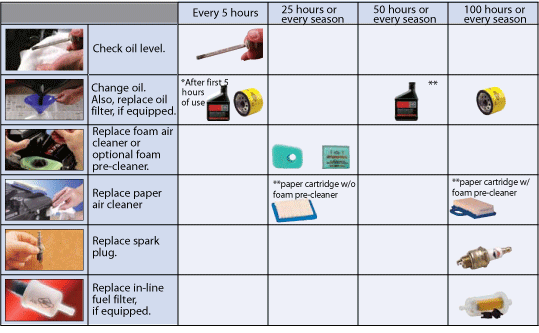
This image is property of www.briggsandstratton.com.
Regular Cleaning
Remove Debris from the Deck
Regularly removing debris from the deck of your lawn mower is essential for keeping it in good working condition. Over time, grass clippings, leaves, and other debris can build up on the deck and obstruct the cutting blades. This not only affects the appearance of your lawn but also reduces the mower’s efficiency and can lead to premature wear and tear. To remove debris, you can use a brush or a leaf blower to sweep or blow away any accumulated grass clippings and leaves. It is important to do this after each use to prevent any build-up.
Clean or Replace Air Filter
The air filter in your lawn mower helps to prevent dust, dirt, and other particles from entering the engine and causing damage. Over time, the air filter can become clogged with debris, reducing airflow and affecting the mower’s performance. Therefore, it is necessary to clean or replace the air filter regularly. To clean the air filter, remove it from the mower and tap it gently to remove any loose dirt or debris. If the air filter is excessively dirty or damaged, it’s best to replace it with a new one. Regularly inspecting and maintaining your air filter will help keep your lawn mower running smoothly.
Clean the Spark Plug
The spark plug is a vital component of your lawn mower’s ignition system. It produces the spark needed to ignite the fuel and start the engine. Over time, the spark plug can become dirty or fouled, resulting in poor engine performance and difficulties starting the mower. To clean the spark plug, first, disconnect the spark plug wire to prevent accidental starts. Then, remove the spark plug using a spark plug socket and inspect it for any signs of fouling or wear. If necessary, clean the spark plug using a wire brush and a spark plug cleaner. If the spark plug is severely damaged or worn, it is recommended to replace it with a new one.
Clean the Blade
The cutting blade is a crucial part of your lawn mower, as it is responsible for cutting the grass effectively. Over time, grass clippings, dirt, and debris can accumulate on the blade, making it less efficient and causing an uneven cut. Regularly cleaning the blade will help maintain its sharpness and ensure a clean and even cut. To clean the blade, first, remove the spark plug wire to ensure safety. Then, tilt the mower on its side and use a wire brush or a scraper to remove any grass clippings or debris stuck to the blade. Remember to wear gloves and take proper precautions when handling the sharp blade. Once cleaned, check the blade for any signs of damage or excessive wear. If needed, it may be necessary to sharpen or replace the blade for optimal cutting performance.
Oil and Lubrication
Check and Change the Oil
Checking and changing the oil in your lawn mower is an essential maintenance task that should not be overlooked. The oil lubricates the engine’s moving parts and helps to minimize friction and heat buildup. Over time, the oil can become dirty or contaminated, which can affect the mower’s performance and potentially cause engine damage. To check the oil, ensure the mower is on a level surface, remove the oil cap/dipstick, and wipe it clean. Then, reinsert the dipstick into the oil fill opening without screwing it in, and remove it again to check the oil level. If the oil level is low or the oil appears dirty, it is time to change the oil. Follow the manufacturer’s recommendations for the type and quantity of oil to use, and be sure to dispose of the old oil properly.
Lubricate Moving Parts
Properly lubricating the moving parts of your lawn mower is essential for ensuring smooth operation and minimizing wear and tear. Without adequate lubrication, the mower’s engine, wheels, and other components can become stiff and difficult to operate. Regularly lubricating these parts will help extend their lifespan and maintain optimal performance. Use a multipurpose lubricant or oil to lubricate the mower’s wheels, axles, pulleys, and any other moving parts as indicated by the manufacturer’s recommendations. Take care not to over-lubricate, as excess lubricant can attract dirt and debris, which can lead to further issues.
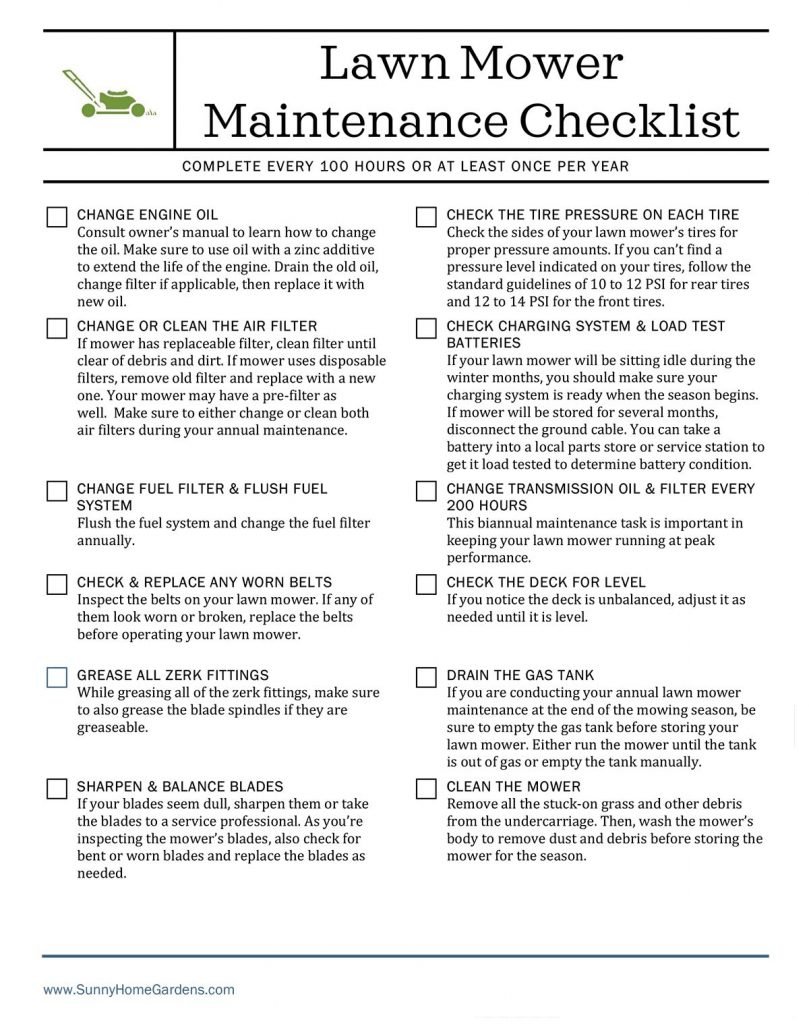
This image is property of sunnyhomegardens.com.
Check the Fuel System
Inspect the Fuel Tank
The fuel tank is where the gasoline or fuel mixture is stored before being used by the lawn mower’s engine. It is important to regularly inspect the fuel tank for any signs of damage or leaks. A damaged fuel tank can lead to fuel leaks, which pose a safety hazard and can result in engine damage. Additionally, inspecting the fuel tank allows you to ensure that it is free from debris and contaminants that can clog the fuel system.
Clean or Replace the Fuel Filter
The fuel filter in your lawn mower helps to keep the fuel clean and prevent contaminants from entering the engine. Over time, the fuel filter can become clogged or dirty, restricting fuel flow and affecting the mower’s performance. It is important to clean or replace the fuel filter regularly to ensure proper fuel delivery to the engine. To clean the fuel filter, remove it from the fuel line and use compressed air or a brush to remove any dirt or debris. If the fuel filter is excessively dirty or damaged, it is recommended to replace it with a new one.
Check the Fuel Line
The fuel line is responsible for carrying fuel from the tank to the engine in your lawn mower. Regularly checking the fuel line for any signs of damage or blockages is crucial for maintaining proper fuel flow. Look for cracks, leaks, or any signs of wear on the fuel line and replace it if necessary. Additionally, ensure that the fuel line is not kinked or twisted, as this can restrict fuel flow.
Inspect and Adjust the Blade
Check Blade Sharpness
A sharp blade is essential for a clean and effective cut. Over time, the cutting blade can become dull or damaged, resulting in an uneven or ragged lawn appearance. Regularly checking the sharpness of the blade is necessary to ensure a quality cut. Carefully inspect the blade for any chips, nicks, or dull areas, and sharpen it if needed. Sharpening the blade can be done with a file or a grinder, following the blade’s original angle. If the blade has extensive damage or wear, it may be necessary to replace it with a new one.
Balance the Blade
A balanced blade is crucial for maintaining the stability and smooth operation of your lawn mower. An unbalanced blade can cause excessive vibration, which not only affects the mower’s performance but also puts additional stress on the engine and other components. To check the balance of the blade, remove it from the mower and place it on a blade balancer. If one side of the blade is consistently heavier than the other, it indicates an imbalance. To balance the blade, remove small amounts of metal from the heavier side until it rests evenly on the balancer.
Adjust Blade Height
Adjusting the blade height is necessary for achieving optimal cutting results and maintaining the health of your lawn. Different grass types and mowing conditions may require different blade heights. Most lawn mowers provide multiple height adjustments to accommodate varying grass lengths. To adjust the blade height, refer to your lawn mower’s manual for specific instructions. Generally, it involves adjusting the cutting deck’s position or individual wheel heights. Remember to adjust the blade height evenly on all sides to ensure an even cut.
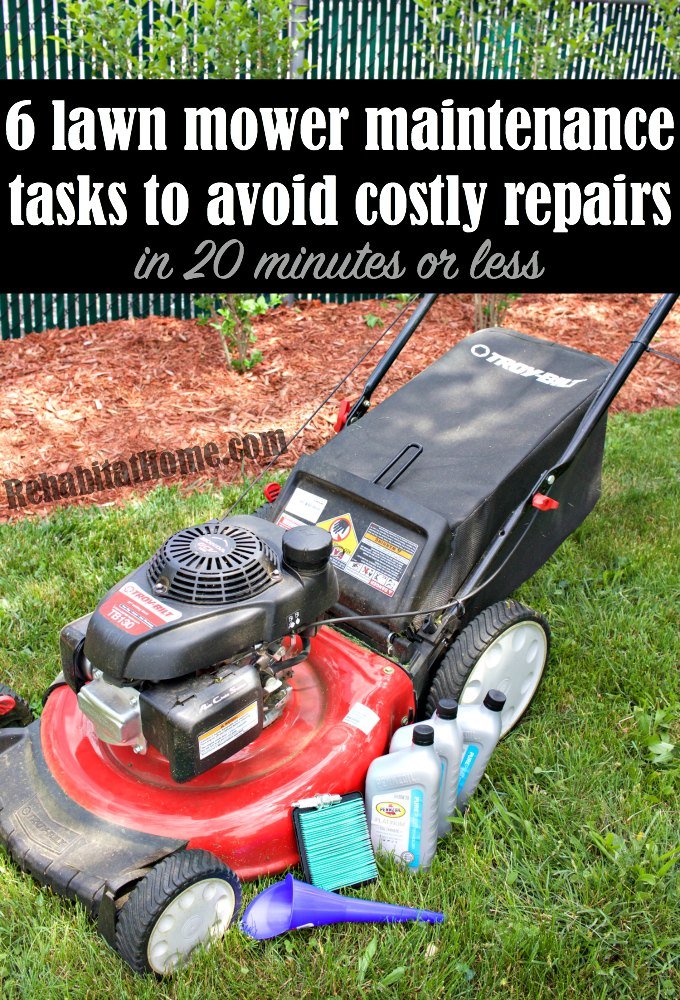
This image is property of rehabitathome.com.
Inspect the Wheels and Tires
Check Tire Pressure
Proper tire pressure is crucial for the stability and maneuverability of your lawn mower. Underinflated or overinflated tires can affect the mower’s performance and potentially damage the wheels or cause accidents. Regularly check the tire pressure using a tire pressure gauge and inflate or deflate the tires as needed to match the manufacturer’s recommendations. Maintaining the correct tire pressure will ensure a smoother and safer mowing experience.
Inspect Wheel Bearings
Wheel bearings are responsible for enabling smooth and frictionless wheel rotation. Over time, wheel bearings can become worn or damaged, resulting in wheel wobbling or difficulty in maneuvering the mower. Regularly inspect the wheel bearings for any signs of damage or excessive play. If you notice any abnormalities, it is recommended to replace the wheel bearings to maintain optimal performance and prevent further damage.
Inspect Wheel Alignment
Proper wheel alignment is necessary for ensuring easy and straight mowing. Misaligned wheels can cause uneven cutting and additional strain on the mower’s engine and components. To inspect the wheel alignment, carefully observe the wheels while rolling the mower in a straight line. If the wheels appear to be tilting inward or outward, it indicates misalignment. Adjusting the wheel alignment is typically done by adjusting the wheel brackets or the axle height on each side of the mower. Ensure that both sides are adjusted evenly to achieve proper wheel alignment.
Check the Battery
Clean Battery Terminals
If your lawn mower is equipped with a battery, regularly cleaning the battery terminals is important for keeping the electrical connections secure and functional. Corrosion or dirt buildup on the battery terminals can disrupt the flow of electricity, resulting in starting issues or electrical system failures. To clean the battery terminals, first, disconnect the battery cables, starting with the negative (-) cable. Then, use a wire brush or a battery terminal cleaner to remove any corrosion or dirt from the terminals. Once cleaned, reattach the battery cables, starting with the positive (+) cable.
Test Battery Voltage
To ensure that your lawn mower’s battery is in good condition, periodically testing the battery voltage is recommended. A fully charged battery should have a voltage between 12.6 and 12.8 volts. Using a multimeter, connect the positive (+) probe to the positive terminal of the battery and the negative (-) probe to the negative terminal. Check the voltage reading on the multimeter. If the voltage is below the recommended range, it may be necessary to recharge or replace the battery.
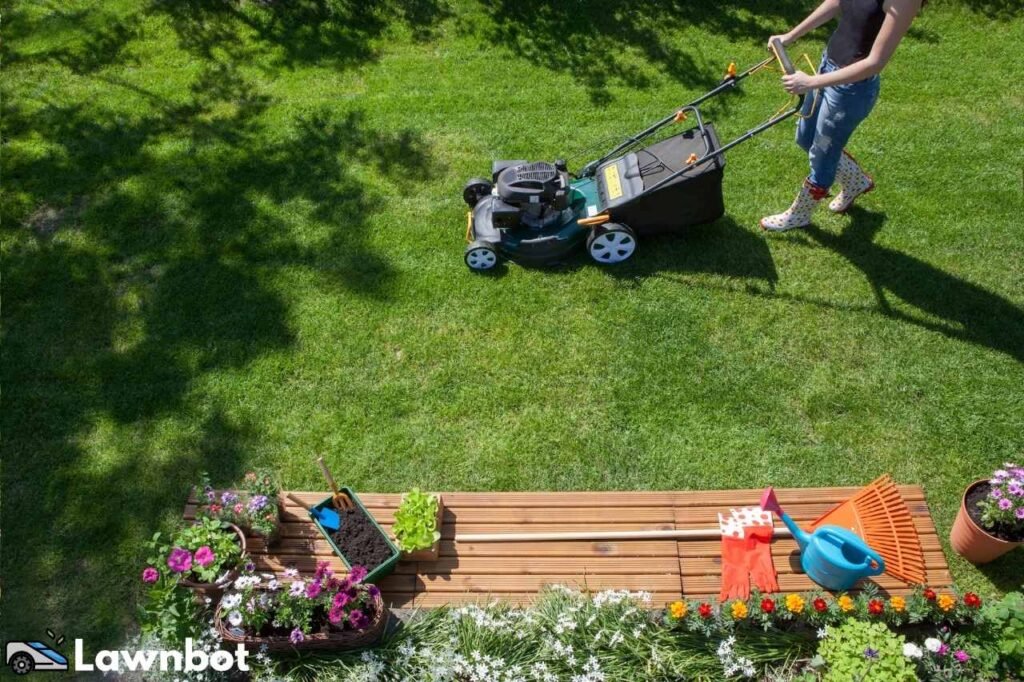
This image is property of robotmaniak.com.
Inspect and Adjust the Belt
Check for Belt Wear
Belts in your lawn mower are responsible for transferring power from the engine to the cutting blades or other components. Over time, belts can become worn, cracked, or damaged, affecting the mower’s performance. Regularly inspecting the belts for any signs of wear or damage is important for preventing unexpected belt failures. Look for fraying, cracking, or signs of excessive wear on the belts. If any issues are observed, replace the belt with a new one to maintain optimal performance.
Adjust Belt Tension
Proper belt tension is necessary for ensuring the effective transfer of power from the engine to the cutting blades. Over time, belts can become loose due to stretching or wear, resulting in reduced power transmission and potential belt slippage. Adjusting the belt tension is typically done by adjusting the position of the belt tensioning pulley or by adjusting the position of the engine. Refer to your lawn mower’s manual for specific instructions on how to adjust the belt tension. Ensure that the belt tension is within the manufacturer’s recommended range for optimal performance.
Check and Adjust the Control Cables
Inspect Cable Condition
Control cables in your lawn mower are responsible for connecting various components, such as the throttle, clutch, or drive system, to the control levers or handles. Over time, control cables can become frayed, rusted, or stretched, resulting in decreased performance or difficulty in operating the mower. Regularly inspecting the control cables for any signs of damage or wear is crucial for maintaining optimal control and operation. If any issues are detected, it may be necessary to replace the control cables to ensure seamless and precise control.
Adjust Cable Tension
Proper cable tension is necessary for maintaining precise control and responsiveness in your lawn mower. Over time, control cables can become loose or stretched, resulting in reduced control effectiveness. Adjusting the cable tension is typically done by using cable adjusters or by adjusting the cable attachment points. Refer to your lawn mower’s manual for specific instructions on how to adjust the cable tension. Ensure that the cable tension is within the manufacturer’s recommended range for optimal control and performance.

This image is property of patfogartylawnmowers.com.
Sharpen and Balance the Blade
Remove and Sharpen the Blade
Sharpening the blade is necessary for maintaining a clean and effective cut. Over time, cutting blades can become dull or damaged due to normal use or hitting hard objects. A dull blade not only compromises the quality of the cut but also puts additional stress on the mower and can result in increased fuel consumption. To sharpen the blade, remove it from the mower and secure it in a vise. Use a file or a grinder to carefully sharpen the cutting edge, following the blade’s original angle. Take care to maintain a balanced edge by sharpening both ends evenly.
Balance the Blade
Balancing the blade is crucial for minimizing vibration and ensuring the stability and smooth operation of your lawn mower. An unbalanced blade can lead to excessive wear and tear on the mower, as well as discomfort for the operator. To balance the blade, remove it from the mower and use a blade balancer. Check the blade by resting it on the balancer and ensuring that it remains level. If one side of the blade is consistently heavier, it indicates an imbalance. To correct the imbalance, remove small amounts of metal from the heavier side until the blade rests evenly on the balancer.
Store the Lawn Mower Properly
Clean and Dry the Mower
Properly cleaning and drying your lawn mower before storage is essential for preventing rust and prolonging its lifespan. Start by removing any dirt, grass clippings, or debris from the mower’s surfaces. Use a brush or a scraper to loosen stubborn dirt, and then use a hose or pressure washer to thoroughly rinse the mower. Allow the mower to dry completely before storing it to prevent moisture buildup, which can lead to rust or corrosion.
Drain the Fuel
Before storing your lawn mower for an extended period, it is important to drain the fuel from the tank and the fuel system. Stale fuel can cause clogging and varnish buildup, which can affect the mower’s performance and potentially damage the engine. To drain the fuel, first, run the mower until it runs out of fuel or stalls due to lack of fuel. Then, remove the spark plug and pour a fuel stabilizer into the fuel tank. Pull the starter cord a few times to distribute the fuel stabilizer throughout the fuel system. This will help prevent the remaining fuel from deteriorating during storage.
Remove the Battery
If your lawn mower is equipped with a battery, it is recommended to remove it before storing the mower. This helps prevent battery drain and potential damage due to temperature fluctuations. To remove the battery, first, disconnect the battery cables, starting with the negative (-) cable. Then, carefully remove the battery from its compartment. Store the battery in a cool, dry place away from direct sunlight and extreme temperatures. Additionally, it is important to periodically charge the battery during storage to maintain its health and prevent it from draining completely.
In conclusion, regular maintenance and proper care of your lawn mower are essential for its longevity and optimal performance. By following this comprehensive lawn mower maintenance checklist, you can ensure that your mower stays in top shape and delivers a clean and beautiful lawn year after year. Remember to always refer to your lawn mower’s manual for specific maintenance instructions and recommendations to ensure the best results. Happy mowing!





